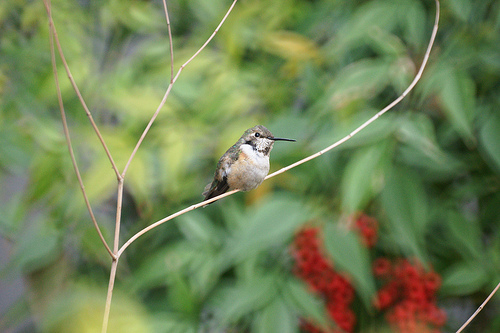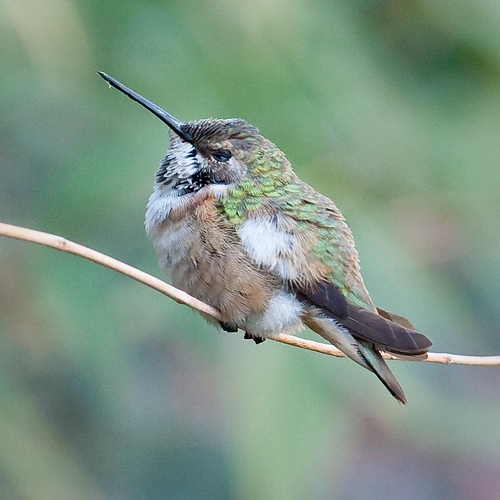It was the first day of spring, and I was on a mission—a fact-checking mission, to be exact. For the past three months, several American Museum of Natural History employees and I had been tracking a Rufous Hummingbird who had lost her way while migrating to Mexico and ended up at the museum, of all places. She’d made our patch of winter-blooming shrubs at the 81st Street entrance her home and had grown into a local celebrity. Some say she’s the first hummer to overwinter in New York. The perfect news hook, I thought, for the first day of spring.
I just had to make sure she was still there. We’d seen the bird regularly the previous week, and as part of the Editorial team, I’d been planning an article for the news blog weeks before that.
But as I approached her favorite spot on my walk to work that morning, I saw white puffs of smoke rise from the shrubs as roaring machines overpowered the shrieks of birds. The throat lump of those environmental destruction moments in FernGully, or Avatar, or The Lorax, or whatever, came. And I panicked.
 The real news, of course, wasn’t that the hummingbird would be there on March 20. It was that she had made it to New York at all, from as far north as Alaska, and had stayed for three whole months. The equinox sighting would just let me put “Spring” in the story title. It was a self-imposed embargo to support a silly news peg that didn’t have any bearing on the true wonder of this little bird.
The real news, of course, wasn’t that the hummingbird would be there on March 20. It was that she had made it to New York at all, from as far north as Alaska, and had stayed for three whole months. The equinox sighting would just let me put “Spring” in the story title. It was a self-imposed embargo to support a silly news peg that didn’t have any bearing on the true wonder of this little bird.
We’ve always been a bit incredulous at the thought of hummingbird migration. The old folklore is that hummingbirds hitched rides on the backs of geese, since no one could imagine enough fuel fitting in such a tiny body to fly over, say, the Gulf of Mexico. Apocryphal, but enough to get mention in an ornithology textbook. These little beings that weigh as much as coins cross mountains, oceans, continents from north to south and east to west. Humans, of such little faith. The literature treats birds that travel outside their normal ranges like outlaws. “Vagrants” is the official term, but my personal favorite is “accidental birds”—as if they cease to be real birds when they stray from the course we’ve charted for them in books.
Or, I realized, on blogs.
She’ll be there on March 20, I kept telling myself as I wrote the story. She’s made it this far. She has to be. The post was prepped and ready to go, but as I ran toward the scene of the crime that morning, not a Rufous in sight.
The scene, I soon realized, wasn’t so criminal. What I had thought were chainsaws were actually leaf blowers. The white haze was a mist from power washing the sidewalk. No one was destroying any habitat. Even if they were, the bird could have headed next door to Central Park to feed on some other plants starting to bloom. Still, did spring cleaning have to be so literal?
At lunch, a few other employees and I scanned the bushes and put people on hummingbird watch in case she returned. One naturalist noticed the landscapers had left some extra leaves by the shrubs that morning, perhaps instructed to do so to give the hummer cover. It was a nice gesture. Nonetheless: no bird.
As I headed back to the office, I couldn’t help thinking that this was my reward for planning news before it happened. I was trying to fit nature into a mold for the sake of a headline. We were all setting this bird in some box: gawking at her for straying so far from her range, for not having dropped dead each week she survived the (mild—but still cold!) winter, for jetting off the day of my story. But nature does as nature does.
And then, just as the day was ending, an email arrived. The subject line: “NEWS FLASH!!” She was back in the bushes. I immediately called up the article on my computer and clicked “Publish.”
I haven’t seen her since.
* * *
Whitney (whitneybarlow.com) is an editorial assistant at the American Museum of Natural History and a science and nature writer in New York City. She loves tracking and studying all living things. Except wasps.
All views expressed here are her own and not the Museum’s.
Images: Anders Peltomaa; Ed Gailland.

One thought on “Guest Post: Notes on Planning Ahead”
Comments are closed.